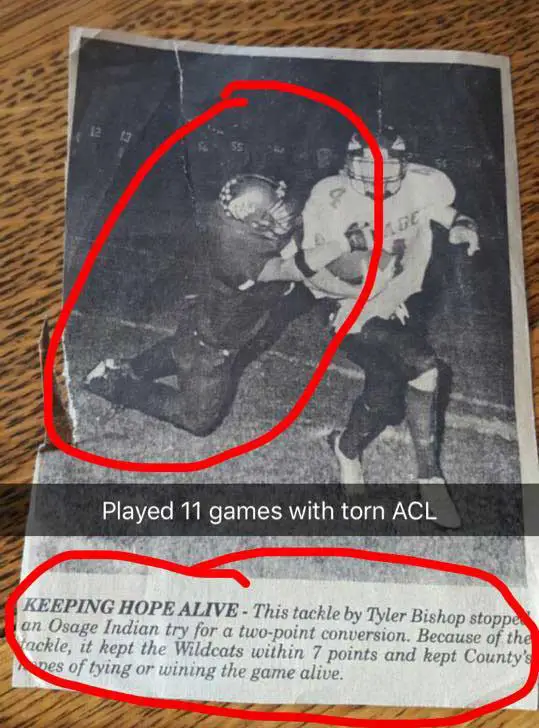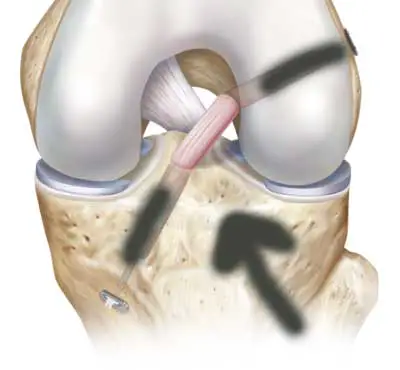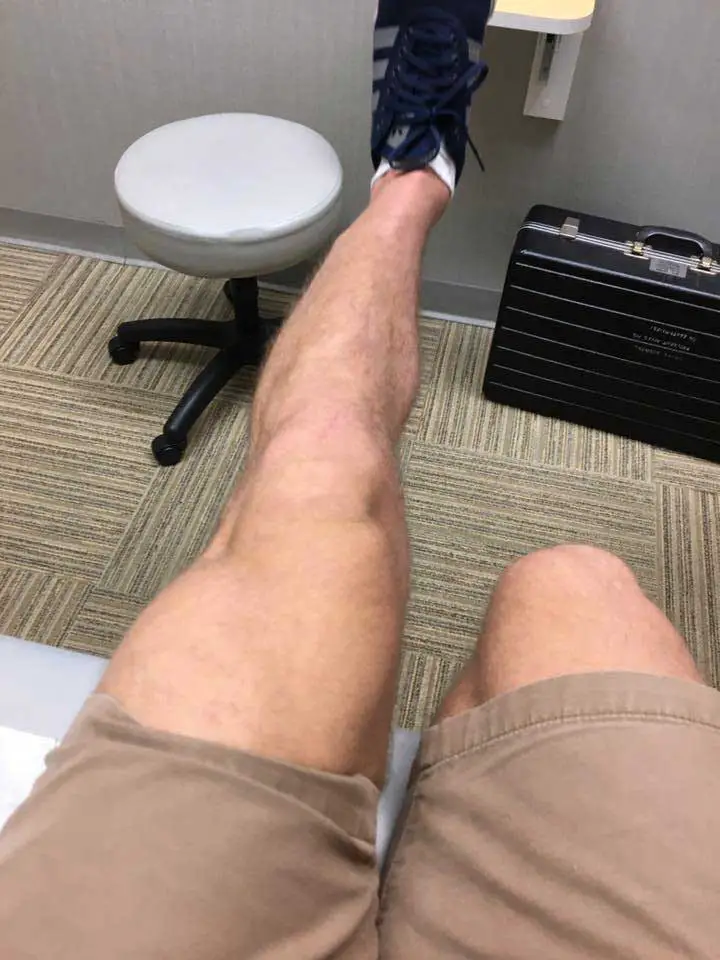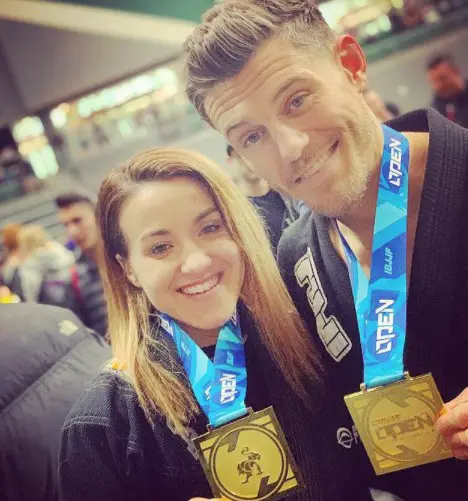By: Tyler Bishop
Competing In & Training Jiu Jitsu With A Torn ACL
Below, I’ll tell you about my first ACL injury and subsequent surgery, my second ACL injury, and my experiences training jiu jitsu and competing in sporting activities without an ACL.
My ACL Injury background
My first ACL injury came in 2003. I completely ruptured my ACL in my left knee. It was a non-contact football injury during training camp. I simply made a sharp cut on the field and down I went.

I actually practiced the rest of that day, but when I awoke the next morning, my knee was the size of a grapefruit (probably a familiar story for anyone going through this). I went to see an orthopedic doctor and was told surgery was really the only option. I was 16 at the time, so that was pretty much the standard wisdom.
I had a lot of trouble understanding why I had to get surgery on something that actually didn’t bother me very much. My high school football coach at the time told me that it was possible to actually play the season without an ACL, so since my knee felt fine to me anyway… I did.
This is not an endorsement of that decision. I’m just trying to give you as much injury background as possible so that you have the full story. I promise I’ll get to the risks and considerations later on.
My knee often felt loose throughout that season and would give way from time to time. If I remember correctly, backpedaling was what seemed to put it most at risk. However, I made it through the whole season and was awarded all-conference and all-district honors at linebacker. Ultimately, I was very happy with my decision to not have the surgery immediately.
After the season, I was convinced that my athletic and personal future would likely be better if I was to repair my ACL. So following that season of football, about 8 months after the initial injury, I had the surgery.
My original ACL graft choice
I find this subject really interesting because a lot of doctors disagree on it. For my first surgery the doctor I had elected for a patellar tendon graft. Recovery from the graft was very slow. I had trouble getting my quads to “fire” again after surgery; which delayed some of my rehab. I was just a kid then, so I doubt I was as considerate or diligent about many aspects of recovery as I would be now, but nevertheless, I did do a full rehab protocol.

Side note: I am not endorsing any one type over the other; as expert opinions are all over the map. However, the patellar graft is known to take much longer to recover from. If I was to do another ACL surgery I would elect a cadaver graft this time (this is just based on my experiences and the experiences I’ve seen other athletes like myself go through first hand).
Recovery from my first ACL surgery
I remember being able to back in the gym working out and training 6 months after the surgery; however, I was not full strength until a very long time after that. I don’t remember the following football season (after the surgery) as being one where I was quite as effective or quick off the ball as I was during the one I played with my ACL tore (this is often the prognosis — athletes usually don’t return to full form until at least 18 months on average).
Note: Many suggest a patellar graft is the worst for grappling because it can take longer than normal to feel comfortable resting on your knees due to scarring and recovery time from the incision point on the end of your knee.
I would say that my original recovery took 18-24 months until I was back to full-strength, but I’m not sure I’ve ever gotten back to where I would have been had I not had the original injury.
13 years later I tore that same ACL again
The next 13 years went pretty well for that reconstructed ACL. Unfortunately, in October of 2016 (at the age of 29), I completely tore my reconstructed ACL graft on my left knee. So basically, I tore the same ACL again.
This time I did it training Jiu Jitsu. I tore it playing lasso guard during a sparring session. There was an audible pop but very little pain.
When I woke up the next morning the knee was certainly swollen, but nothing like the first time I tore the ligament. I was actually pretty sure I had just sprained the knee. I was able to keep training jiu jitsu the following day with no restrictions.
The big concern in the back of my mind was that my knee was feeling a bit looser, but there were no other signs at the time so I plowed forward. Unfortunately, that honeymoon period didn’t last long. In two separate instances in the following weeks, my knee shifted on me when defending double leg takedowns.
It concerned me enough to go see an orthopedic doctor and have a new MRI done on that knee. Sure enough, I had completely torn my reconstructed ACL graft.

What the doctors said about my torn ACL
So, I probably should have mentioned this earlier, but I really am trying to make this as short and helpful for others as possible. When I elected to play through that football season a decade earlier with the ACL torn the doctors were pretty surprised by my knee’s ability to maintain stability during most tasks and thought I was a rare athlete that might be able to compete in my sport without an ACL. I have always had naturally strong legs and will chalk some of this up to good genetics (ha, I guess).
The doctors in my most recent instance felt the same way. I shared with them that I had been training jiu-jitsu and working for a little over a month with the injury with almost no issues; despite two occurrences of some light shifting of the knee.
They decided to do a displacement test in which they would check the laxity in the knee to give me a better idea of what was dealing with. In the test, they found that my injured knee and normal knee experienced the same amount of laxity (even when force was applied). This meant that my injured knee was unusually stable (very unusually apparently). Subsequent tests showed that my injured knee was actually more stable.
The advice I was given (by what I can safely say was one of the best orthopedic doctors in San Diego) was that I may be able to carry-on without the surgery.
“Will training without an ACL put me at risk?”
Due to the stability of my knee, I was at a very low risk of further injury. They said the common perception that the ACL is preventing a larger more catastrophic injury is overblown. The probability of another major knee injury is about the same with or without an ACL. The true risk for non-repair is shearing of the meniscus over time in way that causes the meniscus to erode. This could lead to an early knee replacement.
In my case, there were no instances of shearing and almost no chance that a major injury would occur (unless it would simply occur anyways).
My doctor told me that it really came down to how I felt about the knee and what my goals were.
My first goal was to not have surgery. I hated it the first time around and really didn’t want to do it again; however, I didn’t want to be unable to potentially compete again and train to my full potential either.
He saw no issue with delaying surgery to see how I could potentially cope with a rehab-only approach to recovery. However, he thought it would take monitoring over time if I stick with this choice, so that I could avoid possible meniscus damage in the future.
He recommended a very diligent rehab program that was at least 8 weeks long and focused on building both quad and hamstring strength. He thought that doing these activities would give me the tools I needed to ultimately make my decision.
He very much emphasized (and I will as well), if your knee feels good. Don’t rush to surgery.
Choosing rehab over ACL surgery
I choose a highly recommended rehab facility in San Diego to do my knee rehab. I figured dedicated time there, plus time on the mats, would give me the data I would need to decide if I could really train and compete in jiu jitsu without an ACL.
The first month of rehab, I noticed that I was starting to get a lot stronger. The trainers were very impressed with my strength and stability coming in, but pushed me really hard and could tell I made progress every time I went.
Each week of rehab made my time sparring and rolling at jiu jitsu more and more comfortable. I was able to take more and more risks every day and felt very comfortable on the injured knee.
My ultimate goal was to train for – and compete in – a large tournament as a way of testing my choice.
What was rehab like?
The rehab protocol they had me follow emphasized stretching a lot. They wanted my hip flexors and hamstrings especially flexible. I thought I was flexible before, but they made me spend a lot of time stretching these things and I can say it definitely made a difference.
I usually did 3 sets of 3 separate stretched for calves, hamstrings, groin, and hip flexors. I would do this at rehab every time I went (about twice a week), but I also did it at home (2x every day!). They encouraged me to be diligent with it, so I was religious.
I completed my rehab stretching and basic strength exercises every day (sometimes multiple times day) on my own.
As for rehab exercises, they had me focus a lot on plains of movement. This meant lots of single-leg exercises where I was often stepping out at different angles and squatting down while my other leg would remain fixed and straight. They had me use weight for this as well, but most of the movements were challenging without at weights at first (even for me).
They said they wanted me to fully correct and strengthen my gait (which was a little off).
I did these exercises just about every day along with the stretching. I also started doing some of my own ACL rehab exercises that I found online. I pretty much supplemented everything they wanted me to do with other stuff I could scrap together online.
3 months without surgery + training + rehab = ?
After about 60-90 days of rehab and training, I felt extremely strong and had no feelings of instability. I operated with no loose feeling in my knee and trained jiu jitsu without restriction. I had no shifting instances and found my game to be confident again.
The biggest issue I have now is that I still hold back in some positions when I spar with really tough training partners. It’s more me protecting my knee than it being a problem.

Competing in jiu jitsu with a torn ACL
Since the injury, I have only competed twice:
- IBJJF Europeans — 6 months after injury
- IBJJF Portland Open — 2.5 years after injury
I figured If I could make it through training and competing without any major issues, that would be a pretty good indicator that I might be able to hold off surgery for a while. If not, then I would need surgery.
Training went really well, so I arrived at the tournament very confident. I was able to secure the bronze medal at the Euro’s (at black belt, Master, Middle) with absolutely no issues with my knee.
I went 4-1 on the day and was relatively happy with my effort. I’m angry about that bronze medal as well. I took another black belt’s back in the semi-finals in front of God and everybody….. anyway… I’m not bitter about it.
2 years after the Europeans and training without both ACLs … Oh…
I tore my other ACL at some point (shrug)
Yeah, I should have mentioned. I tweaked my other leg (previously no known issues) and had an MRI done.
Turns out, that ACL was one too. They actually didn’t see any evidence that it had been there recently. This meant I had torn that one a long time ago and had no idea.
So, not much of a decision to make there given my current trajectory.
The 2nd tournament years after tearing both ACLs
With no ACLs, and a career that consumed the majority of my time, I didn’t have much of a desire to compete anymore. However, I found a free period where I was able to train and prepare for the Portland Open in 2019. I competed at black belt and had 3 matches on the day.
I was able to win the gold and submit all of my opponents en route to one of my best performances.
Did not having an ACL bother me? No. I was used to it.
Does not having an ACL impact grappling performance?
Yes. It would be silly to say it doesn’t. I have to be selective about my wrestling and more selective about specific positions and situations.
After years of training without ACLs I don’t even have to think about it anymore though. My body keeps me out of trouble naturally. That said, I do twist or hurt my knee in rare instances and it’s probable I’d have less swelling or time off if the ACL protected me a little better.
Ultimately, I run approximately 30 miles and still train 4-5 times in a typical week as well. I have no issues doing either and feel I still perform well physically/
I don’t wear a brace anymore and have no plans to repair the ACLs in either knee.
My final thoughts
I tore my ACL a second time a decade after my first tear. I have had previous athletic experience that included competition without an ACL. My first surgery was terrible and after my most recent injury I was not excited about doing it again.
I pursued any option I could of not having surgery, and have succeeded so far. I know that long term it may not be a winning strategy and I may have to opt. for an operation. However, I was able to take 3rd at the European Championships with a torn ACL and Gold at a major Open against very tough competitors.
You cannot ignore data. The data my body has given me so far is that it is OK. If it chooses to tell me different I have to act on that data. People will often look for hope in ignoring surgery, my advice is to use the data to decide. Does your knee bother you, can you rehab it to where it doesn’t? If not, you should probably fix it. But, don’t rush into surgery just because you think it is your only option.
Get a good doctor, work your butt off, and see what happens.